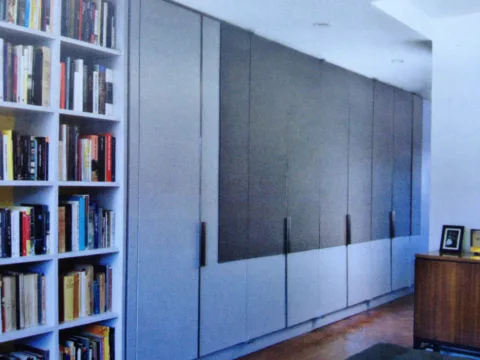If you’ve ever lived in or near an apartment complex, then you’re probably familiar with the many different kinds of noises that come from so many people living in one area.
Even when you own a home, the noises coming in from the outside can sometimes be bothersome.
You may have already considered soundproofing a room — or your entire house!
If you’re concerned about the level of noise coming into your house or apartment, you’ll be glad to know there are some simple things you can do to soundproof your home for a quieter, more peaceful environment.
I’ve lived in some secluded neighborhoods in the past where I wasn’t concerned about noise. But, now I’m a city-dweller, so here are some DIY tips for soundproofing your home that have helped me cut down on outside noise.
How Sound Travels
Sound travels in waves that can move through glass and water, as well as air.
The way that humans perceive sound is determined by vibration, as well as noise wave frequency and decibels — which are the loudness of sound.
Noises in the average home tend to rest around 50 decibels. For comparison’s sake, the noise level at music concerts can exceed 100 decibels.
Some people are more sensitive to noises than others however, and may perceive certain sounds as louder or more irritating. Pets too — here’s what you need to know about dogs and loud noises.
Soundproofed rooms can give you and your family more privacy. They can also add extra insulating value, as well.
Here are the 3 biggest things to consider when soundproofing a room yourself:
#1 – Soundproofing The Noise From Windows
Windows are tricky because you want to let in natural light during the day — so you probably don’t want to cover them up with heavy blankets. Thankfully, that’s not the only way to soundproof a room.
First, if you’ve got single-pane windows in your home, it’s time for an upgrade.
Consider installing double-pane windows to significantly block the outside noise. Contrary to what you might think, triple-pane windows aren’t any better than double-pane windows soundproof-wise though.
If you choose laminated glass, you’d be able to block out the noise even more. And true soundproof windows are best of all because they block 90% to 95% of the noise — but they’re super expensive!
Obviously, upgrading the windows is easy to do if you own the home. But if you’re a tenant like me, just speak honestly to the landlord about it. Chances are, if the windows are really bad, they will pay for new windows. Often landlords are just waiting until a tenant or two speaks up before they decide to make any significant changes.
Next, make sure that your windows are properly sealed — because more sound will get through if the window seals are weak.
If you’re a homeowner, you can seal air leaks by caulking and replace the weatherstripping. You could also inject a foam sealant between the window frame and the house.
If you’re an apartment dweller and your windows aren’t well-sealed, you could cover the windows with heavy fabric, drapes, or an acoustic quilt at night — when noises tend to be the most inconvenient. You can also apply peel-and-stick weatherstripping around the window’s edges.
#2 – Soundproofing The Noise Between Apartments
When the neighbors in the adjoining apartments are watching TV too loudly or sound like they’re wearing cement blocks for shoes, you might first talk to your landlord about floor thickness and wall thickness issues that you’re experiencing.
But there are still a few things you can do to soundproof a room yourself — without damaging the walls or leaving anything permanent behind:
- Hang thick sound barrier blankets
or noise reducing curtains
over windows (or even just on the walls).
- Put soundproofing tape around exterior doors — because sound doesn’t come through a door, it comes from around the door.
- .
- Use a white noise machine or run an appliance (like a fan or air purifier) to reduce the amount of noise you’re hearing.
- Put sound dampening foam between the wall and your furniture.
For what it’s worth, noise blocking techniques work best if action is taken on both sides of the wall. So, if you’re on good terms with your neighbors, you might consider talking with them about soundproofing the wall on their side by using similar methods — to further reduce any noise between apartments.
#3 – Soundproofing The Noise Within Your Home
You can use most of the same methods for soundproofing an apartment or a house, but being a homeowner gives you a few more liberties.
You can actually construct soundproofing barriers inside your walls.
You remove the drywall, add another wall frame inside your wall, and anchor it to the studs already in place. This is known as decoupling or adding space between the 2 sheets of drywall.
Here’s how to do it yourself:
- Fill the walls with damping compound
or another type of acoustic insulation.
- Then cover it with thick drywall.
- Finish by using acoustic caulk
to seal the cracks.
- You might want to consider installing sound clips which have heavy rubber parts — to absorb even more sound.
If this sounds like too much work, or if you want to block noise even further, you can install soundproofing acoustic panels — which are available in a variety of sizes and price ranges.
All factors considered, most homeowners pay between $1,068 and $2,632, with the average soundproofing job costing about $1,733. Source
The Downsides To Soundproofing A Room
Even after taking all of these steps, keep in mind that it’s nearly impossible to block out 100% of the noise. However, you will be able to significantly reduce the amount of excessive noise that seeps into your home using the tips above.
There are only 3 downsides that I can think of that might cause you to think twice before soundproofing a room inside your house:
- The installation process can be rather inconvenient if you’re putting soundproofing in the walls after your home is already built.
- The soundproofing panels
installed on the walls in plain sight might be viewed as an eyesore to family members and guests.
- Soundproofing your home may also prevent you from hearing sounds you want or need to hear — such as a child crying in the next room or a tornado siren going off in your area.
More DIY Soundproofing Tips & Tricks
In addition to the links I’ve included above, here are some more resources to help you when soundproofing a room or two in your house:
- 4 Ways To Soundproof Your Home For Less Than $100
- How To Find A Soundproofing Contractor Near You
- Top 10 Soundproofing Materials
- 9 Secrets To Soundproofing Your Home
- The Difference Between Soundproofing & Sound Absorbing
- Best Materials For Sound Absorption
- Tips For Soundproofing Specific Rooms In Your Home
- How To Build A Soundproof Wall Yourself









